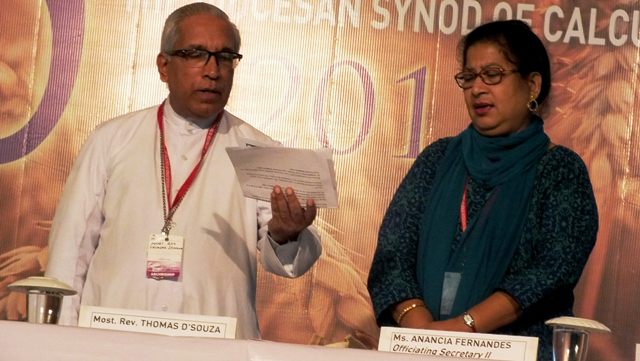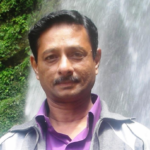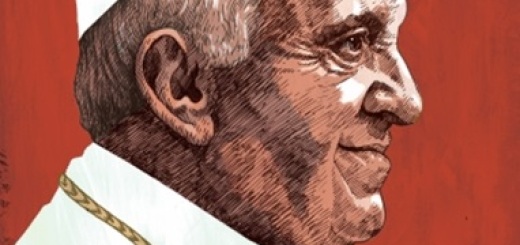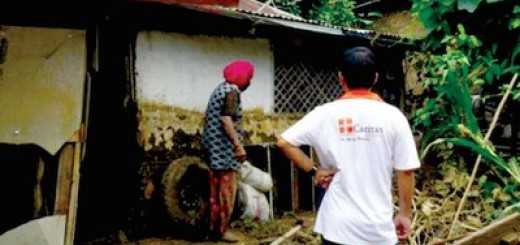Archdiocese of Calcutta concludes Historic Synod

Cover Photo: Most. Rev. Thomas D'Souza, President of the Synod, sings the Synod 2017 anthem, with Ms. Anancia Fernandes, one of the two Synod Officiating Secretaries.
LACROIX INTERNATIONAL
PARIS, FRANCE
October 3, 2017
The Calcutta Archdiocese in eastern India has concluded its historic synod making a series of proposals to prioritize gender equality and environmental concerns in its pastoral plan.
The synod discussed issues such as inter-religious dialogue, education, environment and social justice, evangelization, family, healthcare, laity, small Christian communities, social communication, women and youth.

(Photo: Archdiocese of Calcutta)
The September 26-30 synod was attended by 88 priests, 23 religious nuns, 37 laymen and 13 laywomen, representing all Catholics in the archdiocese.
Archbishop Thomas D’Souza of Calcutta convoked the synod following norms prescribed in church law to have such a gathering to help with pastoral planning.
The archbishop opened the synod, explaining that the body of Latin rite bishops, the Conference of the Catholic Bishops of India (CCBI), wanted a pastoral plan to be evolved for the church in India, keeping in mind the renewal ushered in by Vatican II in different areas of the life of the church.
The Calcutta Archdiocese, established in 1886, is a Latin-rite diocese. India has three rites — Latin, Syro-Malabar, and Syro-Malankara. The Eastern Churches — Syro-Malabar and Syro-Malankara —trace their origin to St. Thomas the Apostle while the Latin Church began with Western missionaries in the 15th century.
In February 2013, a pastoral plan for the church in India was approved by the bishops of the Latin rite, according to a press note from the archdiocese. On the same line, the Calcutta Archdiocese decided to evolve a pastoral plan in two stages — a parish pastoral plan and an archdiocesan pastoral plan.
Efforts toward this started in March 2013. Of the many tools used for animation of parishioners, was a set of 12 booklets in English and the local Bengali language. The booklets set out the doctrinal and pastoral aspects of each of the 12 concerns leading to the formulation of the pastoral plan.
The delegates made several proposals to improve the local church. The suggestions were sent to the archbishop for his decision and possible declaration as synod decisions.
“Unless these proposals are approved and declared by the archbishop as synod decisions, we cannot publicize them,” said synod secretary Jesuit Father Irudaya Jyoti.
“The delegates did engage on some of the concerns such as education of the poor, equality of women and social justice,” he said. The announcement of the synod decisions is to be made November 27, Father Jyoti said.
 The Synod 2017 held at Morning Star College, Barrackpore, was hailed as Historic. Isaac Gomes, Associate Editor, Church Citizens' Voice shares some insights, for the readers and their friends.
The Synod 2017 held at Morning Star College, Barrackpore, was hailed as Historic. Isaac Gomes, Associate Editor, Church Citizens' Voice shares some insights, for the readers and their friends.
The high point of a Synod, immediately after the closing ceremony, is the Declaration (Decree) on the Resolutions adopted. At the Closing Ceremony of the Synod on 30th September, very surprisingly, the Archbishop of Calcutta who convoked the Synod, made no such declarations. To the Laity of Calcutta Archdiocese, it was a washout. The Archbishop just announced that 161 Synod members selected by him had deliberated on the 12 Concerns of the Archdiocesan Pastoral Plan. He said the findings/proposals would be finalised by the Archdiocesan Pastoral Plan Core Team (APPCoT) in October. After this he would announce the recommendations to the Laity on 26th November Corpus Christi Day (and not on 27th November 2017 has been quoted in the report). The implementation time is Five Years.
From the inception of the Archdiocesan Pastoral Plan in 2012-13 and its launch in August 2015, four years have gone by till date (September 2017). By adding another five years' time-frame, around ten years will have gone by. By that time, many parish priests will have been transferred and the whole process in many parishes will have to start afresh. In spite of having been officially launched in August 2015, many parishes of the Archdiocese, are yet to launch the Pastoral Plan in their own parishes due to reasons best known to the Archbishop.
Now why is this vetting of Synod proposals by APPCoT? It only shows that the Archbishop did not have faith on the collective wisdom of his people whom he had hand-picked for the Synod. Why did he hold the Synod then? Just to parade the numbers and make a heavy weather, whereas in effect it was decided that APPCoT would call all the shots? All the proposals on the various Concerns were put on vote at the Synod and the results should have been out there only, UPFRONT. Why is this holding back for APPCoT to override/ water-down / set aside the resolutions taken at the Synod? In fact what is the specific role of APPCoT? It should have been disbanded after the official launch of the Archdiocesan Pastoral Plan in August 2015. As per the grapevine, the participants were not given a copy of the proceedings and of the proposals put on vote. These were only flashed on the screen and made to vanish. Reminds one of "The Gypsy Girl Vanishes into the Blue!"
In this context mention may be made of two participants who were part of the Synod.
One asked me "Which Concern out of the 12, does Parish Finance Committee come under?" A classic example of the depth of knowledge of 170+ jewels hand-picked by the Archbishop for the Synod. What was the process of their selection? Merely on the weight of the Chairs they occupied? Were they tested on their knowledge of the Archdiocesan Pastoral Plan on the 12 Concerns, to be eligible for representing their parishes/archdiocese?
The second was the Secretary of the Laity Commission. In his opening speech at the closing ceremony, he said that by convoking the Synod 2017, the Archbishop of Calcutta was very courageous as he had opened the floodgates of public opinion. The fact is 99.5% of the public (Laity) of the Archdiocese was kept out of the Synod! The doors were simply SHUT. In this age of digital communication, interested members of the laity from each parish could have been taken on board, on-line or through video conference, to give their viewpoints. And the Synod could have been PARTICIPATORY instead of it being a CLOSED-DOOR AFFAIR. After all it is their Pastoral Plan and their voices matter much more than those of the wise priests & nuns and men & women gathered at the Synod.
The Secretary of the Laity Commission made another faux pas. He said that the Archdiocesan Pastoral Plan was launched in the Archdiocese on 15th August 2015 after several years' consultation. The fact is, it was officially launched on Sunday 9th August 2015! I distinctly remember the date as the Archdiocesan Social Communications Commission (ASCC) had deputed me to cover the launch at Fatima Parish, Kolkata and to report the event including those of the other parishes, on the Archdiocese website.
Since there is so much hush-hush on the findings at the Synod deliberations, let us take a peek on what happened there:
1. Midnapore representatives told the Archbishop that the Archdiocese was not showing interest in several areas of Midnapore. It was pointed out there was hardly any action on the Education front and there were no official documents on this from the Archdiocese.
2. Proposals were made for the creation of an Education Fund.
3. This fund will be raised at the parish level. (What a joke. If parishes, especially the poor ones, have to set up an Education Fund themselves, then why the Synod and big talk on Education Policy)?
5. For Health, it was proposed to set up a fund at the Archdiocese level. Funds to be raised from schools, parishes and the wealthy. Seva Kendra (the Archdiocese NGO) will help in this.
6. Health proposal includes setting up of medical college, nurses training centre and nursing home in Kolkata.
7. To ensure transparency, accounts are to be published once a year, in the Herald, the official mouthpiece of the Archdiocese of Calcutta. (The Herald itself does not have its own account. It's accounts are merged with the Archdiocese Account).
8. The Archbishop asked all parishes to institute Parish Finance Committees (PFCs) to ensure transparency. As per the Archbishop's Circular dated 31st May 2014, ALL Parishes in the Archdiocese of Calcutta were to have the Parish Finance Committees in place by 1st October 2014 at the latest. Three years have gone by. Still most parishes do not have a PFC and the list of defaulters is not published. A very sad commentary on the transparency in financial affairs in the Archdiocese which is yet to publish the Accounts of Mother Teresa Canonisation Celebration Committee though more than a year has gone by since Mother's Canonisation! The Archbishop of course harps on transparency in various forums. Contrary to the perception of the powers-that-be in the Archdiocese, the Laity of Calcutta is not asleep!!
9. Fr Vincent Lobo, erstwhile Dean of Calcutta, mentioned at one of the Pre-Synodal meetings that most of the members of the Synod are priests and nuns and there should be more representation of lay persons. He said the ratio of priests and religious to laypersons was 2:1. He was correct. Out of the 161 Synod participants (reported by Fr. Irudaya Jothi), priests and religious totalled 112, the rest being laypersons. There is a clear mix-up of priorities.
10. The Secretary of Laity Commission proposed that Lay leaders of the Church should be recommended as leaders to the outside world (read political, Government)! This clearly smacks of vested interest by certain church leaders who want to use the Church as a springboard to promote their hidden agendas. This is the reason they cling on to their posts by hook or crook and resist every attempt to reform the consitution of their Associations. They believe in Chalta Hai, Chalnay do!
11. The Secretary of Laity Commision (who made him Secretary is a mystery) also proposed that there should be an annual appraisal of all priests and nuns. Several priests and nuns got offended (obviously because they are used to making Report Cards of others), stood up and protested. They did not want this proposal to be put to vote. One priest said there was no such system in place. But the Archbishop, to be politically correct, vetoed them. He said he too should be evaluated. It was however, not spelt out how the annual appraisal would be done and who will do it. Will it be a cross-section of members of the Laity or the same lay leaders who are on all Church Committees & Commissions and wear different hats for different occasions?
All proposals were put to vote through secret ballots.
Secrecy and not transparency, shrouds the Synod!
Midnapore representatives said most of the deliberations and presentations were in English and there was hardly anything in Bengali for them to comprehend the proceedings of the Synod. After all it is West Bengal where due weightage must be given to the local language Bengali. They demanded that Midnapore be declared a SEPARATE DIOCESE being so vast and neglected by the Archdiocese.
None of the Archdiocesan Pastoral Plans on the 12 Concerns including their Bengali translations put up on the Archdiocesan website archdioceseofcalcutta.
Midnapore's proposal for a separate diocese is not an isolated event. To be fair to the Archbishop, the Archdiocese of Calcutta is too vast an area for him to do pastoral justice single-handedly, however best he may try. Bombay Archdiocese has three Auxiliary Bishops, Ranchi has two. It's high time the Archdiocese of Calcutta had two more Auxiliary Bishops before demand for further break-up of the Archdiocese crops up. In keeping with the doctrine of Inculturation, these Bishops should be sons of the soil to nurture and boost local culture and vocation.
There is a clear mismatch between the figures (161 participants as above) reported by Fr Jothi, reporting secretary and those announced by the Archbishop during his closing ceremony (videoed) speech. The Archbishop announced 88 priests, 23 consecrated women, 1 consecrated brother, 37 laymen and 38 laywomen participated in the historic Synod. This adds up to 187.

















Why is there no Finance Committees in the parishes? The Synod should take up the issue seriously and not just wishy washy affairs which remains ritualistic and ornamental. Money generates power and power corrupts. Absolute power corrupts absolutely.
Francis Rosario, USA
The fact is that the entire church machinery is manipulative, distorted, dishonest and corrupt. Those are really blessed who hold on to the basics of faith.